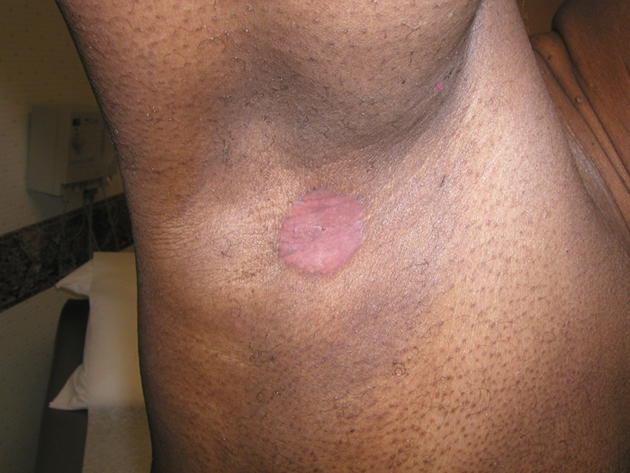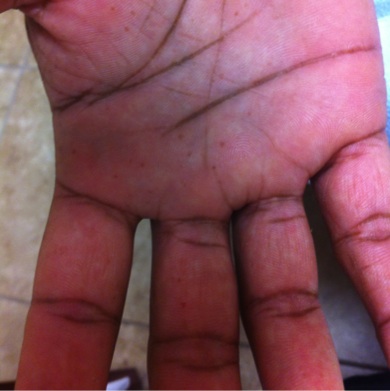CORRECT DIAGNOSIS:
Primary Cutaneous Diffuse Large B-Cell Lymphoma, Leg-Type
DISCUSSION:
Cutaneous lymphomas are categorized into two subtypes: T-cell and B-cell lymphomas. B-cell lymphomas represent an estimated 25% of all cutaneous lymphomas. There are various types of cutaneous B-cell lymphoma including follicle center B-cell lymphoma, marginal zone B-cell lymphoma, B-cell lymphoblastic lymphoma, diffuse large B-cell lymphoma, leg type, and diffuse large B-cell lymphoma. Primary cutaneous diffuse large B-cell lymphoma, leg type (PCBCL-LT) is a rare, intermediately aggressive form of primary cutaneous B-cell lymphoma that is characterized by the presence of large round cells on histopathology. PCBCL-LT almost exclusively has an advanced age of onset with a median age of 77 years (Grange Sep 2007). Females are more commonly affected. Clinically, patients typically present with solitary or grouped erythematous to red-brown nodules on the distal aspect of the lower extremities, but may occur on any part of the body, and tend to develop over weeks or months. The lesions may ulcerate and rarely may mimic venous ulcers of the leg. Prognosis is less favorable than other types of cutaneous B-cell lymphomas with a 5-year survival of approximately 50%.
TREATMENT:
Treatment includes chemotherapy in the form of CHOP-R, which includes one monoclonal antibody inhibitor, oral steroid, and 3 chemotherapy drugs, specifically, rituximab (an anti-CD20 antibody), prednisone, vincristine, doxorubicin, cyclophosphamide. Relapse following treatment and extracutaneous spread has been commonly reported. Our patient was referred to oncology to initiate CHOP-R therapy.
REFERENCES:
Grange, F., et al. (2007). Primary cutaneous diffuse large B-cell lymphoma, leg type: Clinicopathologic features and prognostic analysis in 60 cases. Archives of Dermatology, 143(9), 1144. https://doi.org/10.1001/archderm.143.9.1144
Grange, F., Bekkenk, M. W., Wechsler, J., Meijer, C. J., Cerroni, L., Bernego, M., et al. (2001). Prognostic factors in cutaneous large B-cell lymphomas: A European multicentric study. Journal of Clinical Oncology, 19, 3602-3610. https://doi.org/10.1200/JCO.2001.19.3602
Willemze, R., Jaffe, E. S., Burg, G., et al. (2005). WHO-EORTC classification for cutaneous lymphomas. Blood, 105(10), 2768-2785. https://doi.org/10.1182/blood-2004-06-2079
Kodama, K., Massone, C., Chott, A., Smolle, J., Kerl, H., & Cerroni, L. (2005). Primary cutaneous large B-cell lymphomas: Clinicopathologic features, classification, and prognostic factors in a large series of patients. Blood, 106(7), 2491-2497. https://doi.org/10.1182/blood-2005-02-0418
Brodell, R. T., & Santa Cruz, D. J. (1985). Cutaneous pseudolymphomas. Dermatologic Clinics, 3(4), 719-734. https://doi.org/10.1016/S0733-8635(21)00046-5
Choi, T. S., Doh, K. S., Kim, S. H., Jang, M. S., Suh, K. S., & Kim, S. T. (2003). Clinicopathological and genotypic aspects of anticonvulsant-induced pseudolymphoma syndrome. British Journal of Dermatology, 148(4), 730 -736. https://doi.org/10.1046/j.1365-2133.2003.05216.x




